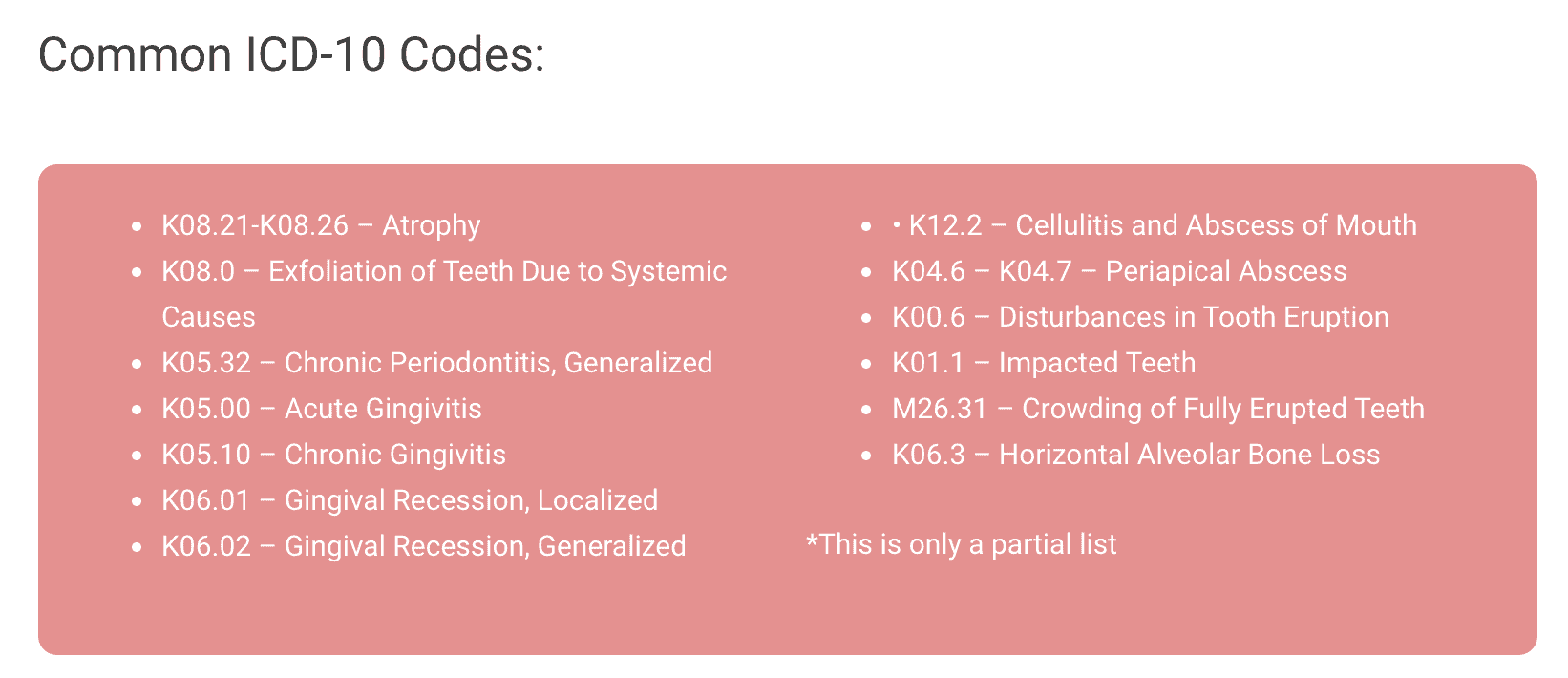What are dental procedures, and why do they matter?
Dental practice owners are always searching for ways to improve efficiency and appeal to patients. Being familiar with the differences between medical and dental procedures, especially in terms of billing and insurance, is one great way of doing so. Having a better understanding of billing for dental procedures allows you to improve transparency. You can deliver that transparency by having clear-cut answers for patients as to whether their insurance can cover a particular procedure.
This guide will help you understand the differences in billing and explain them to your patients. The result should be improved customer satisfaction and efficiency.
What are the differences between medical vs dental procedures?
The biggest difference between medical and dental procedures comes down to the condition that is treated or prevented. Medical procedures are part of diagnosing or treating medical conditions. While that distinction seems straightforward, what counts as a medical condition can be confusing at first.
Diabetes would be an example of a medical condition, while an overbite would be a dental condition but not a medical one. There are also conditions like abscessed teeth that count as both. As you get more practice classifying conditions as either medical or dental, it becomes easier to do.
With that distinction in mind, most medical insurance will cover procedures that are necessary to treat diagnosed medical conditions. An example would be a dental procedure that is necessary after a traumatic injury or from an infection.
To make the distinction even clearer, we’ll go through examples of each category.
Why does it matter? Major trends influencing dental procedures
You need to understand what procedures count as medical and which are dental so you can ensure that you bill them properly. If you accidentally send a bill for a dental procedure to a patient’s medical insurance, it will be denied. The patient would need to pay for it out of pocket or go through the hassle of getting their dental insurance to cover it. Being familiar with billing codes is also helpful in preventing errors.
Understanding dental vs medical procedures also makes it easier to explain the difference to patients. This helps them better understand what to expect in terms of what they will have to pay for out of pocket and which insurance company will be billed.
The most common dental procedures
The important distinction of dental procedures is that they do not treat a medical condition. They are purely related to oral health and dentistry. As such, each of these is billed to your patients’ dental insurance companies, not their medical insurance.
Teeth Cleanings
Teeth cleanings are the most common dental procedure that you likely offer. Dentists recommend having cleanings done every six months, so you theoretically complete this procedure on every single patient twice (or more) each year. It is when you use professional instruments to thoroughly clean patients’ teeth. It also typically involves a quick diagnostic element to ensure that nothing is wrong with their oral health.
Fillings
Fillings are easily one of the most common dental procedures. They are the most common method for treating cavities, and this dental procedure is quick.
Crowns
Crowns are another treatment for cavities, and you use them when there is too much tooth decay for a filling to be effective.
Teeth Whitening
Teeth whitening is a common procedure that many insurance companies classify as cosmetic. You apply a special gel or solution to your patients’ teeth for a set amount of time to whiten them.
Veneers
Veneers are the thin coverings that go over teeth or sets of teeth. They can help with correction and whitening and are considered dental procedures.
Extractions
When you extract a patient’s tooth, this is typically not part of treating a medical condition. As such, it qualifies as a dental procedure.
Orthodontics
Orthodontics involves straightening a patient’s teeth or adjusting the teeth’s overall alignment. As mentioned earlier, an overbite doesn’t count as a medical condition, so this is a dental procedure, not a medical one.
Types of dental surgery (medical procedures).
We already mentioned that medical procedures include any dental treatment that treats a medical condition. Additionally, dental surgery always counts as a medical treatment. The same is true of anything that diagnoses a medical condition, including imaging. Treating issues like pain that can lead to loss of function are also medical procedures.
All of the following examples should be billed to your patients’ medical insurance.
Dental Implants
Dental implants count as dental surgery, making them a medical procedure. Dental implants involve placing lightweight and sturdy screws in the jawbone so you can attach a crown to the top of them.
Bridges
Bridges are groups of prosthetic crowns, typically with a dental implant on each side. The inclusion of the implant makes this a dental surgery.
Root Canals
Root canals are easily among the most common and most dreaded dental surgeries that will typically be covered by medical insurance. This surgery involves removing the part of a tooth that is decayed to extract the infected pulp.
There are also surgeries related to root canals that remove infected pulp but aren’t quite root canals. Pulpectomies, pulpotomies, and apicoectomies still typically count as medical procedures, so you would usually bill them to medical insurance.
Bone Grafting
Sometimes, you need to perform bone grafting before an implant or even without an implant. This involves encouraging more bone to grow in the jaw. It can be used to strengthen the jaw enough for an implant or to overcome jawbone deterioration.
Wisdom Tooth Extraction
Extracting the wisdom teeth is when you extract the four adult teeth in the back of the mouth. It is typically only required if the teeth are impacted, cause pain, or lead to infections. You may also suggest removing them even without issues, as this eliminates potential issues in the future.
Reconstructive Surgery
Reconstructive oral surgery is typically done after trauma. It can include treating fractures and soft tissue injuries.
Cosmetic Surgery
Cosmetic dental surgery is unique among these dental surgeries, as not all dental or medical insurance plans will cover it. If it is covered, it will typically be billed to medical insurance, but that depends on the plan.
The most basic dental procedures cost little to no money for the patient.
The most basic dental procedures also tend to be the most affordable. Most of these will be billed as dental procedures through your patient’s dental insurance. In some cases, the insurance may only cover a certain number of treatments. For example, many insurance companies only cover two teeth cleanings a year, so patients that need more than that may have to pay out of pocket.
Dental Exams
Dental exams are among the most affordable appointments, and many insurance companies will cover two per year. These are considered preventative care, as they let you spot issues in a patient’s mouth before they worsen and become harder to treat.
Professional Cleanings
Another basic dental procedure with low out-of-pocket costs for patients is professional cleanings. In most cases, the insurance company will cover two regular cleanings per year. They may or may not cover deeper cleanings, which are more expensive.
Dental Sealants
Dental sealants are easily one of the most affordable dental treatments, as they tend to cost about $20 to $40 per tooth. This involves applying a thin coating to the chewing surfaces on the teeth to prevent tooth decay.

How to improve patient satisfaction through transparency.
The cost of treatment is typically a major concern for dental patients, so you want to use the above information to reassure them and offer clear information. If you can convey the information clearly, this can become a competitive differentiator between your dental practice and others.
Patients will appreciate it if you take a human-to-human approach when discussing billing and insurance with them. This makes the experience less stressful. As you discuss dental costs & financing with patients, encourage questions and answer them clearly. It is also smart to ask the patients questions to confirm they understand the information you gave them.
It is also smart to ensure that everyone on your team is on the same page. Receptionists, dentists, office managers, hygienists, and everyone else on the team should take the same approach and have similar recommendations.
It will also help your practice if you accept payments in various methods, including with payment plans. For patients who are concerned about the costs, share some of your knowledge on low-income dental care assistance.
Conclusion – why dental procedures matter.
Your ability to clearly and concisely explain the difference between billing for medical and dental procedures will do wonders for your customer satisfaction. That, in turn, will boost your overall patient retention.
With the help of Podium’s communication tools that start for free, you can turn those satisfied patients into more business.




